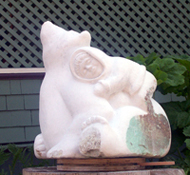Wiki-Up Wanderings - July/Aug 2002
- Details
- Created: Monday, 01 July 2002 21:36
 In June 1, we brought ‘The Big One’ home. I figured I had done all of the major grinding and shaping and was down to details and final finishing. The house was no longer in “dust danger”. My yard works fine for that, and with all of the hoopla of summer vacation and kids home, I want to be here and would probably not get down to the studio on a regular basis. I will miss the sights, sounds and smells of the group studio, so will visit on occasion to see what everyone is up to. With help from Phil and Frances, we loaded and transported my now 450 lb. stone, again using farmboy physics.
In June 1, we brought ‘The Big One’ home. I figured I had done all of the major grinding and shaping and was down to details and final finishing. The house was no longer in “dust danger”. My yard works fine for that, and with all of the hoopla of summer vacation and kids home, I want to be here and would probably not get down to the studio on a regular basis. I will miss the sights, sounds and smells of the group studio, so will visit on occasion to see what everyone is up to. With help from Phil and Frances, we loaded and transported my now 450 lb. stone, again using farmboy physics.
The Story of The Big One
Once upon a time, there was a mama polar bear who came upon a small Eskimo child. The child was lost, cold, alone and frightened, but did not know to be frightened of the big white warm bear.
The bear enveloped the child in her warm body heat and soft fur and the child, relaxed, warmed and trusting, fell asleep, cuddled on the bear’s haunch. The child is oblivious to the apparent danger of being with such a large carnivorous critter. The bear, however, is on full alert, head back, nose up, sniffing the air for the scent of danger. She knows that this child does not belong with her. She knows that if she is caught with the child, her life will be endangered. She will be killed, most likely, in her attempt to return the child to other humans. She also knows that she cannot keep the child with her. She cannot keep it warm, safe, and fed in the world she lives in.
This is the tension/dilemma of the piece. What should she do? I call it “Scent of Man”.
As with most of my work, the subject matter relates to my life. I do this unconsciously, and only figure out the connection as the piece develops. My son just graduated from high school. And so, at 18 and off to college in the fall, he no longer belongs with me, but I am not ready to send him out into the world either where he may not be safe
I am going to rough finish the edges of the parka, polish the face, and leave the bear a matte finish. There are areas of unfinished, untouched, stone left alone just as it was quarried and weathered over the years. The piece is basically triangular and these untouched areas are on all sides, showing I used the stone to its outer limits in all directions.
This project with all of its fits and starts has been within my mind’s focus for a year now. I contrast that to the soapstone walrus I started and finished in two afternoons on a rainy May weekend. That little project lifted my spirits immeasurably, but briefly. The long term project, when finished, will have a lasting satisfaction.
People remain quiet when they look at it, and I still don’t know if that is because they don’t understand it, don’t like it, or don’t know what to say. At this point, other people’s reactions are less significant to me. I know what it is all about, and it speaks to me. Maybe that is all we should ask for sometimes.
And now, as I close out my year of writing for the newsletter, I thank NWSSA for this opportunity to express my “stone soul”. I know that the next carver who takes my spot will reveal new and inspiring aspects of this art. It has been great fun.

 Q: What is quarry sap?In the book, The Agony and the Ecstasy, Michelangelo is said to have draped the David marble in damp cloth after every carving session. What was he doing?
Q: What is quarry sap?In the book, The Agony and the Ecstasy, Michelangelo is said to have draped the David marble in damp cloth after every carving session. What was he doing?